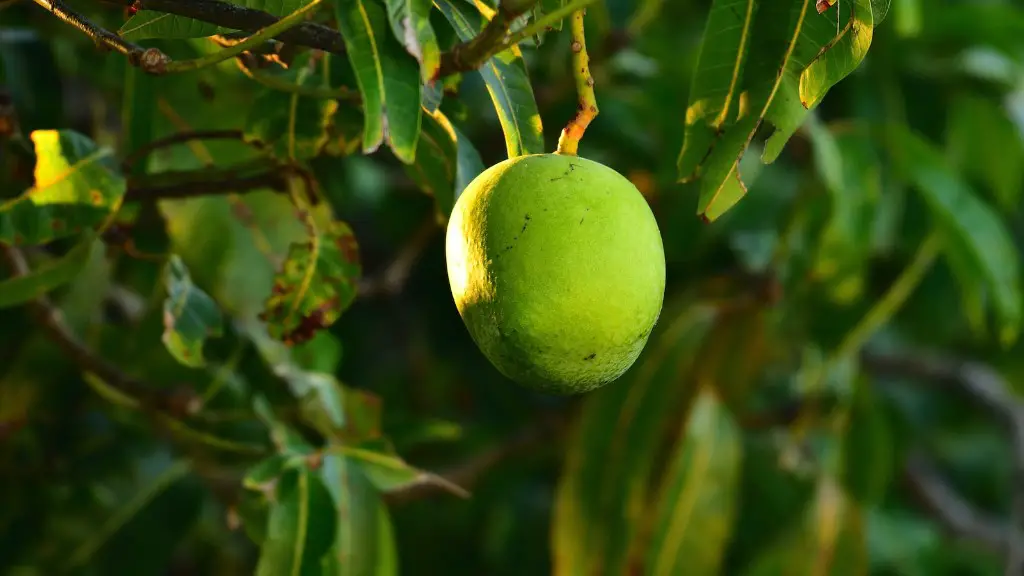Background
Avocado is widely known and loved by many. Due to its popularity, many people are curious as to whether an avocado is a tree or a bush. The short answer is – it depends. An avocado could be both a bush and a tree depending on its size. This article aims to provide an in-depth analysis into what exactly an avocado is and the differences between a tree and a bush.
Tree or Bush?
The common question of whether an avocado is a tree or a bush brings several questions to mind. Botanists define a tree as “a woody perennial plant with a single stem or trunk, growing to a significant height and having many branches of leaves”. A bush is usually defined as “a low-growing plant usually under 6 feet tall”, with many branches at its base. Generally, an avocado tree grows to a height of between 30 to 40 feet, and is considered a tree at this size. However, when an avocado is a small and young plant, it could be considered a bush, as it does not have a single stem or trunk and does not reach a significant height. As such, the question of whether an avocado is a tree or a bush is not a simple one and requires more analysis.
Characteristics
The avocado tree is a tropical to subtropical fruiting tree known scientifically as Persea americana. Its trunk is often twisted and gnarled, and its foliage is evergreen and oval-shaped. The leaves are dark green, leathery and glossy, adding to its aesthetic appeal. The flowers of the avocado tree are white or greenish and can be male, female or both sexes on the same plant. The fruit produced by the avocado tree are large, rounded and contain a single large seed. The skin of an avocado fruit is usually green and leathery, and the flesh inside is bright green to yellow.
Cultivation
Avocado trees are well-suited to mild climates. The optimum temperature for growth is 25°C to 32°C, though they can also withstand heavy rainfall and occasional frost. In general, avocado trees need direct sunlight and adequate moisture in order to thrive. They should also be planted in well-drained soil, away from strong winds.
Care & Maintenance
In terms of care and maintenance, avocado trees usually require regular pruning and fertilisation to ensure the production of the best quality fruits. They do not require complex pruning, but young trees need to be trained early on to develop a strong trunk and branches. As for fertilisation, avocado trees need a general purpose fertilizer that is low in nitrogen and high in potassium.
Diseases & Pests
Avocado trees are unfortunately susceptible to certain diseases and pests. One of the most common diseases an avocado tree can suffer from is root rot, caused by over-watering or poorly drained soil. They are also susceptible to fungal diseases such as anthracnose and black spot. As for pests, mealybugs and whiteflies are the two most common pests that can affect avocado trees.
Harvesting & Uses
Avocado fruits can be harvested once they are ripe and when they have split open. They can be eaten fresh, or used as an ingredient in salads and sandwiches. Avocados are also used to make guacamole, a popular dip. Avocados can also be processed into oils, butter and margarine.
Symbolic Value
Avocados have come to symbolise wealth and fertility in many cultures, due to the emergence of the nickname “the alligator pear.” The variation of the fruit’s name highlights the idea of the avocado being a symbol of something luxurious, due to its large size and dense, creamy flesh. Additionally, avocados are also filled with essential vitamins and minerals.
Nutritional Benefits
Avocados offer a wide range of health benefits. Firstly, they’re high in fibre and contain important minerals, such as potassium and magnesium. They are also a good source of monounsaturated fatty acids, which can help reduce levels of bad cholesterol. Furthermore, they provide antioxidant and anti-inflammatory properties, which can help protect against certain types of cancer.
Environmental Impact
The cultivation of avocados can have an impact on the environment. Firstly, this is due to the water needed to grow them. On average, it takes up to seventy gallons of water per pound of avocados. Additionally, the use of artificial fertilisers and pesticides during cultivation can also pollute surrounding water sources and soil. As such, sustainable farming methods must be adopted, in order to protect the environment and mitigate any potential environmental impacts.
Trade & Global Demand
Avocados remain a popular fruit choice globally and have been one of the most sought-after fruits in recent years. In the US, for example, the demand for avocados has surged due to its numerous health benefits. Furthermore, Mexico remains the number one exporter of avocados and has seen an increase in demand from Europe, Japan and the Middle East.
Economic Impact
The production and consumption of avocados has had a major economic impact in many countries. For instance, in the US, avocado production has increased five-fold in the span of 20 years, leading to the creation of multiple jobs and a boost in the overall economy. Furthermore, in Mexico, the export of avocados has become a pillar of the economy and an important source of foreign exchange earnings.
Consumer Trends
Avocados have become increasingly popular among health-conscious consumers and those looking for healthier food options. This can be attributed to its high nutritional content and its reputation as a ‘superfood’. Additionally, the rise in vegan and vegetarian diets, as well as the popularity of plant-based eating, have also contributed to the rise in the consumption of avocados worldwide.
Global Industry
The avocado industry is worth an estimated $17 billion and remains a significant part of the global economy. Companies such as Avocados From Mexico and J.R. Soucie & Associates have seen a major surge in demand for avocados. Furthermore, initiatives such as the Avocado Quality and Safety Initiative have helped promote quality and safety standards in the production and sale of avocados.
Botany & Classification
The avocado tree belongs to the Lauraceae family of plants, along with other notable plants such as the cinnamon tree, bay laurel and camphor. Its scientific name is Persea Americana and it is believed to have originated in Central America.
Avocado Products
With the rise in demand for avocados, a variety of avocado-based products have emerged. Avocado oils are increasing in popularity as a cooking medium, as well as for skin and hair care. Avocado butter is also becoming increasingly popular for its unique texture and health benefits. Finally, a range of frozen and snack items, such as avocados on toast and avocado spreads, are becoming more widely available.
Supply & Demand
The global supply of avocados is heavily influenced by fluctuations in the demand for the fruit. For instance, in the US, demand has outstripped supply in recent years, leading to an increase in prices. Additionally, production in Mexico is slowing down due to droughts and a reduction in available land.
Conservation
As avocados are increasingly becoming a staple food in many countries, it is important to conserve as much of the fruit as possible. This can be achieved through better production practices, such as growing them without the use of artificial fertilisers and pesticides, or through the practice of reducing water waste. Additionally, the promotion of sustainable trade practices, such as fair prices for farmers, can help ensure the availability of avocados for future generations.


